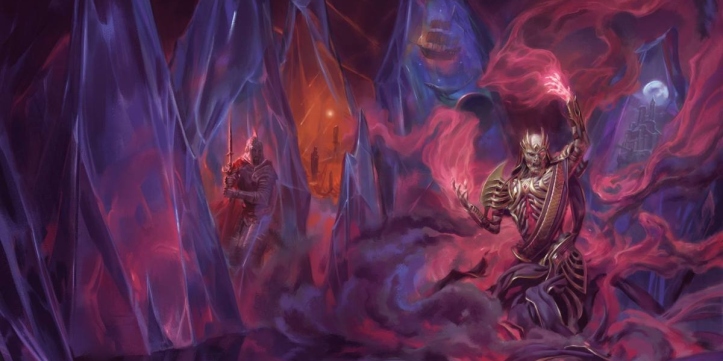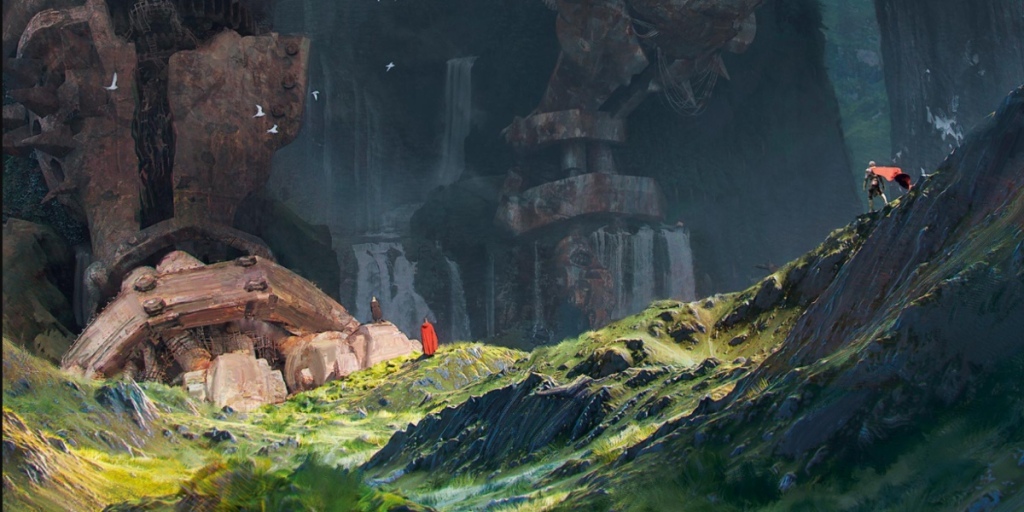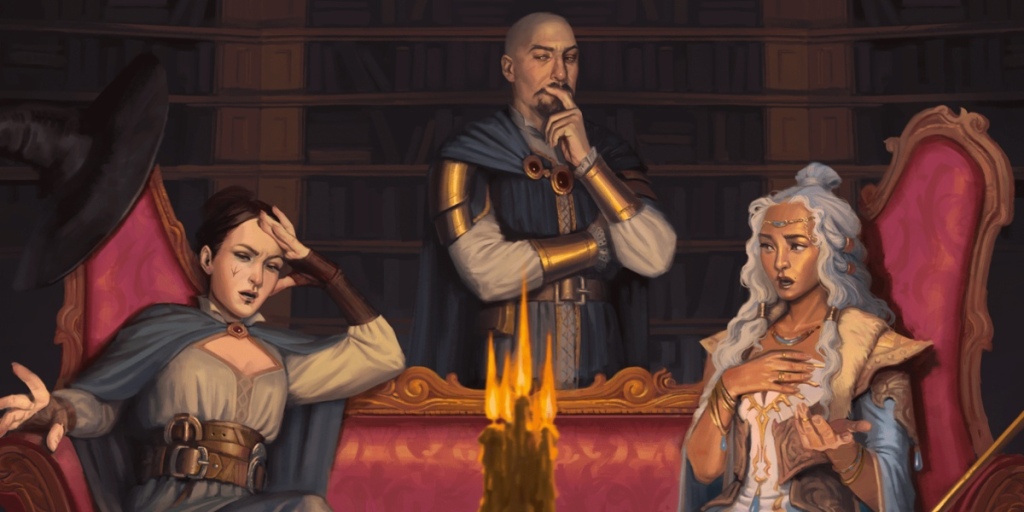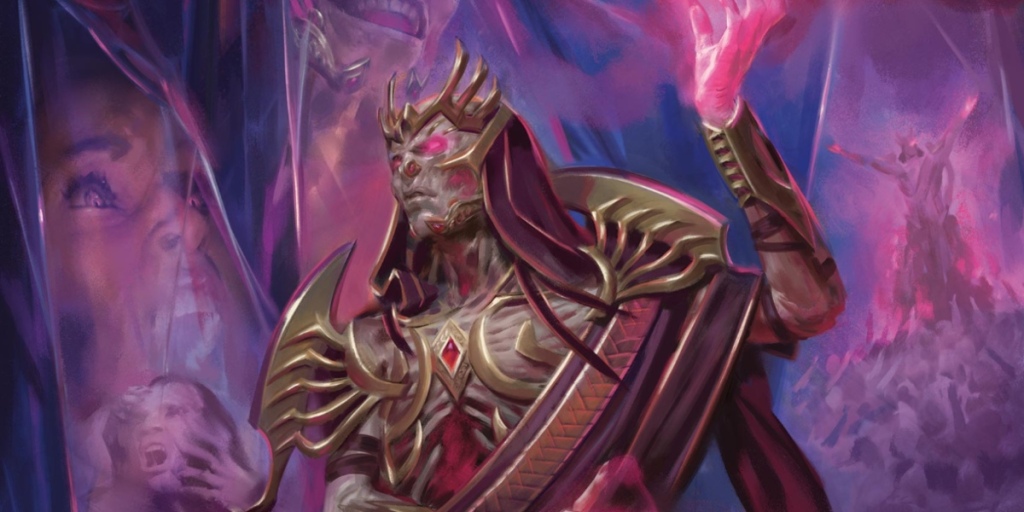Note: This review is spoiler-free. I will be discussing Vecna: The Eve of Ruin as an adventure and some of its choices, but I won’t spoil the twists or give significant details about any setpieces.
Vecna: Eve of Ruin, the final campaign module for Dungeons & Dragons Fifth Edition, has finally been released. It’s available digitally for those who pre-order on DnDBeyond, and available physically in some game stores. Vecna: Eve of Ruin‘s official physical release date is May 21st, 2024.
The campaign is meant as the capstone to the current iteration of D&D 5e, ahead of the Player’s Handbook 2024 reboot. To this end, it tackles far vaster and grander subject matter than any prior release.
In Vecna: Eve of Ruin, the titular archlich and minor god attempts to rewrite reality to make him supreme ruler of the cosmos. The player characters have to travel the multiverse (or most of it that’s already had a D&D 5e hardcover book) to gather the Rod of Seven Parts before coming to a climactic confrontation with Vecna, his allies, and even some of his enemies.
Vecna: Eve of Ruin strives to be epic, with empowered heroes and villains waging war for the multiverse. How does it succeed in these endeavours?
What Sets Vecna: Eve of Ruin Apart?

Vecna: Eve of Ruin clearly wants to be more cinematic than the average D&D 5e adventure. Many have compared it to the Marvel Cinematic Universe’s Avengers: Infinity War or Avengers: Endgame, and they’re not wholly wrong.
Many Vecna: Eve of Ruin setpieces do turn the intensity up. From an unexpected planar jaunt to a running battle through an artificial dungeon to a clash between rival demon armies, it’s a treat for any group whose DM has sufficient narrative flair. On top of that, genuinely fantastic art adds a huge amount to each adventure.
It’s also the first D&D 5e campaign to span from levels 10 to 20 (with only Waterdeep: Dungeons of the Mad Mage matching its cap), floating the option for player characters to come from prior, low-level modules. This does open up many mechanical doors barred in other campaigns, and the game does a reasonable job of handling them.
Vecna: Eve of Ruin also has its unique Power of Secrets mechanic. Almost every adventure has NPC secrets that, due to Vecna’s growing strength, the PCs can use to empower themselves.
Despite an interesting premise, this mechanic largely turns into the DM pointing out how shifty (or sheepish, or surly, or another guilty adjective) an NPC seems, at which point they blurt out their greatest shame when pressed. Even in the book, it feels repetitive.
The information hidden in Vecna: The Eve of Ruin‘s Tomb of Wayward Souls dungeon is the only time this mechanic feels well implemented and woven into an encounter. If it had been repeated across the book, it would be genuinely excellent.
Vecna: Eve of Ruin’s Structure

Vecna: Eve of Ruin has made no secret that it’s a planar fetch quest. The actual story isn’t much more involved than travelling to multiversal locations and grabbing pieces of the Rod of Seven Parts. This, in theory, suits many groups. However, the execution feels lacking.
The session-to-session journey of Vecna: Eve of Ruin quickly settles into a routine. Helpful NPCs (popular faces Mordenkainen, Tasha, and Alustriel) tell the PCs where to go next. The PCs can then research a handful of facts about the area from Sigil. A portal then drops them off almost literally next to their objective (with a couple of exceptions), at which point they dungeon crawl to reach it. Then they level up.
Unfortunately, this gives Vecna: Eve of Ruin a very railroaded feel. The PCs do the locations in the order the book wants them to, have almost no way of doing anything other than the Wizards Three’s goals, and stay on the pre-determined path throughout.
If the PCs had to make choices about how they reached these locations, or even chose where to go in what order, it’d feel much more free. There’s very little freedom in the grand structure of Vecna: Eve of Ruin, and that’s disappointing. Some of the best moments of Curse of Strahd often come from players going unexpected places at unexpected times, for instance.
That said, Vecna: Eve of Ruin does break out of its own funk towards the end, deviating from its structure to provide a suitable climactic finale. This even includes player freedom in dictating its plot.
Furthermore, Vecna: Eve of Ruin‘s structure relies heavily on a central twist. Apart from anything else, this twist is the sort that risks invalidating many sessions of playtime. I can’t imagine my players enjoying it.
Worse, this twist is fairly vital to Vecna: Eve of Ruin as written. If the players figure it out ahead of time, one of the book’s suggestions is simply skipping most of the content and levelling the players up for what they missed. There has to be a more elegant way, particularly given the book’s content costs $70.
The end result is that every campaign of Vecna: Eve of Ruin will have a very similar synopsis, lacking the freedom and variety of Icewind Dale: Rime of the Frostmaiden, Princes of the Apocalypse, or even Out of the Abyss.
Groups who enjoy anthology books like Tales from the Yawning Portal might love Vecna: Eve of Ruin. Players who want a little more agency in their multiversal struggle will be disappointed.
Vecna: Eve of Ruin’s Adventures

I compared Vecna: Eve of Ruin to Tales from the Yawning Portal, and that holds true in many ways. Its adventures are distinctive, separate, and varied, with very little overlap besides the PCs and the Rod of Seven Parts.
Fortunately, most of the adventures in Vecna: Eve of Ruin range from good to excellent. Few come across as mediocre or worse (although the Ravenloft chapter falls well short of Curse of Strahd‘s high standard).
There are two significant drawbacks in Vecna: Eve of Ruin‘s adventure design, but many strengths. Many adventures feel similar. The PCs travel a short way from the portal, meeting a group of largely decent NPCs with secrets of questionable relevance they don’t hold onto very tightly. From there, they crawl through a dungeon to find a piece of the Rod of Seven Parts.
Furthermore, many of the adventures in Vecna: The Eve of Ruin railroad far harder than their equivalents in previous books. They include no way for the PCs to go anywhere in the region that isn’t plot-relevant. Worse, the book tells the DM to ‘encourage’ the PCs in making the right choice, often using NPCs as mouthpieces.
Interactivity is one of the things players treasure most about TTRPGs like D&D 5e. Vecna: Eve of Ruin does try and give players many paths to tackle its dungeons, but it seems lost if they try something the designers didn’t anticipate or want to deal with. This is partly due to the limitations of pre-written modules (especially ones as dense as Vecna: Eve of Ruin), but other D&D 5e campaigns manage it much better.
There are some genuine standouts. The very first prologue chapter, ‘Return from Neverdeath Graveyard’, genuinely impressed me with its moving parts and creative dungeon. Likewise, ‘The Ruined Colossus’ (in Eberron) and ‘The Dragon Queen’s Pride’ (in Avernus), put genuinely entertaining twists on the formula, coupled with excellent setpieces and challenges.
In many ways, the inflexible, standalone structure of Vecna: Eve of Ruin might help the individual adventures. They’re free to put as many moving parts in as they like without long-term butterfly-effect consequences. The multiversal jaunt also allows basically any location to work, however unconventional.
Another strength of Vecna: Eve of Ruin is how many monsters it puts into play. With how much of the multiverse it covers, every adventure offers a brand-new menagerie (often very high CR) for combat-happy players to test themselves against.
Giant spiders are significantly overused, however. A warning to my fellow arachnophobes who want to play Vecna: Eve of Ruin.
Vecna: Eve of Ruin and Fanservice

Vecna: Eve of Ruin is more than another hardcover release. It’s the final campaign before a new D&D 5e version comes out. It’s an attempted love letter to Dungeons & Dragons, particularly its most popular edition. So how does it do?
It’s a mixed bag. Many of the multiversal adventures in Vecna: Eve of Ruin do show off the interesting, beloved, and distinctive features of their planes. However, it’s very much a stripped-back whistlestop tour, with little to thoroughly reward fans of those settings.
Similarly, Vecna: Eve of Ruin throws in some iconic D&D NPCs – only to have them not do much. It’s disappointing to see Alustriel, Mordenkainen, and Tasha as major players in a D&D 5e campaign where their only major role is to offer exposition, morally ambiguous exposition, and snarky exposition respectively.
Where Vecna: Eve of Ruin disappoints most in its fanservice is in the title character. You may have mentioned that Vecna doesn’t get many mentions in this review. This is because he doesn’t get many mentions in the book itself.
Vecna’s plot is the campaign’s impetus, for sure. However, his actions consist of sitting in a cave and promising ominous doom if the PCs take too long. There is no time limit, they can take as long as they want.
Vecna: Eve of Ruin starts off strong with the Whispered One, giving a unique mechanic called Vecna’s Link that ties into the Power of Secrets. However, he doesn’t appear until the very end. Neither do his servants.
There’s no feeling of Vecna’s growing power throughout the universe. No Vecna cultists to clash with. No interaction with Vecna other than violence. Vecna: Eve of Ruin even lacks a high-powered lieutenant to serve as a more active villain and provide personal investment. Hell, the Hand and Eye of Vecna barely get a mention.
Vecna is possibly D&D‘s most beloved villain, even before Stranger Things catapulted his name into the wider world. An adventure with him as its focal point should at least do him as much justice as Curse of Strahd does its antagonist. Instead, it’s a multiversal romp that lacks much Vecna outside of its final section and ominous exposition.
In Summary

Overall, Vecna: Eve of Ruin doesn’t live up to its promise or to the standards of D&D 5e‘s most beloved campaigns. It’s undeniably cinematic and contains great individual adventures, with plenty of potential for entertaining sessions.
However, a far too restrictive plot and frequent missed potential make Vecna: Eve of Ruin feel significantly less than the sum of its parts. Even a genuine uptick toward the end doesn’t quite make it a satisfying experience as a full campaign.
For those who are looking forward to running or playing Vecna: The Eve of War, try reading ‘Five Vecna Appearances to Check Out Before D&D 5e’s Vecna: Eve of Ruin‘. And please let me know how your campaign goes.
For the heights of what D&D 5e has to offer, instead try ‘The Best Official D&D 5e Campaigns‘.
As always, if you’ve enjoyed this, please leave a like and tell your friends. Furthermore, sign up for ArtificialTwenty: Investigation Check here to get the latest TTRPG news. Thank you!